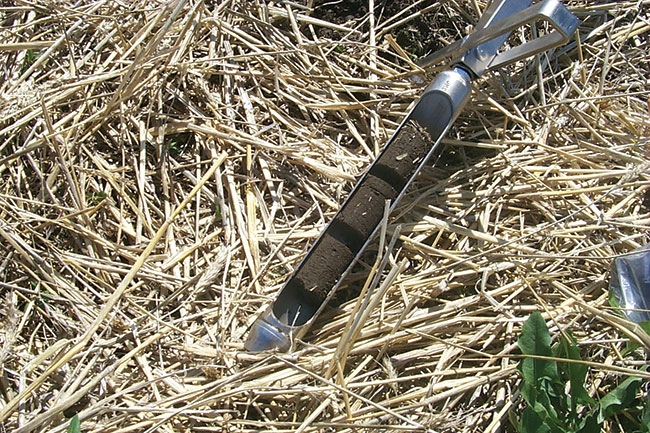
Features
Agronomy
Soil
Enjoying the little things in life
Soil microbes provide billions and billions of teeny helping hands to your crops. Those helping hands are key to sustainable, profitable crop production. Crop growers can choose practices that promote healthy soil microbial communities, and researchers like Bobbi Helgason are developing ways to further enhance agriculture’s ability to tap into the remarkable capacity contained in soil microbial life.
December 12, 2016 By Carolyn King
 Practices such as no-till and reduced tillage help promote soil microbial communities that can perform such vital functions as suppressing plant pathogens Soil microbes provide billions and billions of teeny helping hands to your crops.
Practices such as no-till and reduced tillage help promote soil microbial communities that can perform such vital functions as suppressing plant pathogens Soil microbes provide billions and billions of teeny helping hands to your crops.“Healthy microbial communities perform a wide range of critical ecosystem functions, such as regulation of nutrient availability and pathogen suppression. They decompose organic matter such as crop residues and release the nutrients. And they do many other things, like maintaining soil structure and good hydrology, as well as plant growth control,” says Helgason, a soil microbial ecologist with Agriculture and Agri-Food Canada (AAFC) in Saskatoon.
“All of those processes may go underappreciated sometimes in our farm fields, but having a healthy microbial community is essential to making sure those ecosystem services keep working properly.”
Nurturing a healthy microbial community
“A ‘healthy’ soil microbial community is one that can provide ecosystem services in a way that is balanced and sustainable,” Helgason says. “So to assess the health of a microbial community you need to measure a suite of processes. Those processes might differ depending on what the soil is being used for, for example an annual crop production system versus pasture land. So you might have two very different microbial communities in two different soils, but they are both healthy because they can perform all the key functions that are required.”
A microbial community’s abundance and diversity are indicators of its health.
“Microbial biomass is like the engine that drives biological processes in the soil. The bigger the engine, the more capacity you have to deliver those processes,” Helgason says. If you grow a greater amount of microbial biomass, you increase your soil’s capacity to deliver those key functions.
“Microbial diversity is like taking out insurance. The more diverse a community is, the more likely it is that the community can perform services across a wide range of conditions.” For example, in a diverse community, if one group of organisms gets knocked out when conditions are too wet for it, then a different group of organisms that is suited to wet conditions is poised to step in and keep those processes going.
Sometimes an imbalance in soil conditions, such as too much moisture or low nutrient availability, creates an opportunity for harmful microbes, like plant pathogens, to get a foothold in the soil. However, a healthy microbial community is more likely to be able to outcompete those harmful microbes.
Agricultural practices influence the health of microbial communities. Helgason notes, “Good soil stewardship leads to healthy soils and healthy microbial communities.” She gives some examples of practices that promote healthy microbial communities: balanced nutrient additions; reduced physical disturbance or no tillage; continuous cropping (rather than summerfallowing), so continual plant resource inputs are available as food for the microbes; diverse crop rotations, so a variety of plant inputs are available to the microbes, increasing their activity and diversity; and the use of microbial inoculants, such as rhizobium, when appropriate.
Recovering from carbon starvation
One of Helgason’s recent studies underlined the importance of plant residues as a critical source of energy to drive soil microbial processes and crop yields.
She and her colleagues examined four of the systems in the Alternative Cropping Study, a long-term experiment at AAFC’s Scott Research Farm that compares organic and conventional management systems. One of those four systems was an organic system with a diverse annual crop rotation: lentil green manure-wheat-pea-barley-sweet clover green manure-mustard. This system involved tillage, no chemical pesticides, and no added nutrients from external sources (such as livestock manure, compost or chemical fertilizers).
This organic system had consistently lower yields than the other three systems (two conventional and one organic) over the 18 years the Alternative Cropping Study had been running. To find the cause of those poorer yields, Helgason sampled the soils in the four systems and examined their microbial abundance and microbial functions, including cycling of carbon, nitrogen and phosphorus.
“This particular organic system – despite the use of green manures and legumes in the rotation to add biologically fixed nutrients – developed an imbalance of nitrogen and phosphorus early on, which reduced crop growth,” she says. “The new finding from our work is that the microbial communities in this organic system were not only nitrogen- and phosphorus-limited, but because crop growth was reduced then the crop residue returns were also reduced, so those microbial communities were also carbon starved.”
She explains, “Carbon from crop residues is the fuel or the food for most of the microbial activity in soil. In organic systems, we rely heavily on that microbial activity to release bound nutrients, like nitrogen and phosphorus, and make them plant-available.”
Although plants can fix energy through photosynthesis and give it to the microbial community, their ability to do so in this particular system was impeded by nitrogen and phosphorus limitations. And since no nutrients were added only from biological nitrogen fixation without any additions from livestock manure, compost or fertilizers, there was a net export of nutrients out of the system with each crop harvest.
The result was a negative feedback loop. “There may have been pools of nitrogen and phosphorus that could be released biologically, but the microbial community was too exhausted through carbon limitation to be able to perform those processes in a way that could support crop growth,” Helgason says.
Out of the four systems, the best functioning one was a conventional production system with an annual crop rotation of canola-fall rye-pea-barley-flax-wheat. Helgason says, “This system was being managed very judiciously under best management practices: it was no-tillage; it had a diverse crop rotation; and fertilizers and pesticides were applied based on soil tests and crop scouting.” Its soil had the largest microbial biomass and the greatest ability to perform nutrient cycling and other key functions.
Now Helgason and her colleagues have a new study underway to look at how to restore the productivity to that low-yielding organic system. They are evaluating various soil amendments, such as extra wheat crop residues, livestock manure and compost. These amendments add nutrients, such as nitrogen and phosphorus, and also add organic matter to fuel microbial functions, like nutrient cycling.
Sustaining healthy crops under changing conditions
A related line of Helgason’s research is looking at long-term soil fertility under changing conditions, such as higher yield goals and changing weather trends. “This work is really important for understanding how to maintain long-term fertility under what we anticipate will be increased production goals. If we are producing larger crop yields from the same land base, then how do we ensure soil carbon returns and sustained fertility despite the fact that we are exporting more nutrients out as crop products,” she says.
As part of this research effort, Helgason and her colleagues compared microbial soil carbon transformations in humid conditions in Ontario and semi-arid conditions on the Prairies. They wanted to see how different temperature and moisture conditions affect the way microbial communities transform crop residues into soil organic matter and the amount of carbon remaining in the soil. The increased understanding gained from this research will help in developing soil management recommendations for sustaining healthy microbial communities and crop productivity under changing climate cycles.
Breeding for better crop-microbe interactions
Another area of Helgason’s research involves investigating how the root microbiome – the bacteria, fungi and other microbes that associate with plant roots – interacts with crop roots and how that interaction impacts crop growth and yield potential.
“We’ve got a new study underway to understand the mechanisms a plant can use to select root microbiome partners,” she says. “The end goal is to develop tools that breeders can use in their breeding programs to develop crop varieties that better exploit the inherent capacity of the root microbiome to improve crop growth through improved nutrient uptake or increased stress tolerance or increased pathogen resistance and so forth.”
One mechanism a plant uses to select microbial partners is to release specific biochemical signalling compounds from its roots, called root exudates. These compounds trigger a helpful response in certain microbes. A large, collaborative study co-led by Helgason and Steven Siciliano at the University of Saskatchewan is looking at signalling compounds released by canola, wheat and lentil. Their aim is to determine how those compounds differ between varieties of each crop and how those differences affect the crop’s interactions with the soil microbial community.
For example, imagine several wheat varieties are growing in very dry conditions. Perhaps some of those varieties release a signalling compound that recruits a particular microbial partner, and that partner helps the plants tolerate dry conditions. Maybe the partner is a fungus that responds to the signalling compound by sending out fungal hyphae to locate and bring water to the plant. Or perhaps the microbe causes the plant to improve its water use efficiency, or increase its root growth to access water from deeper within the soil. Other wheat varieties that don’t produce that signalling compound would suffer more from the dry conditions.
Helgason and her colleagues hope to identify key molecules that trigger relationships between crops and service-providing microbial partners.
Soil microbe-crop partnerships are vital to crop production. Research advances will help growers to sustain and enhance their ability to draw on the incredible wealth of help available from soil microbial communities.


